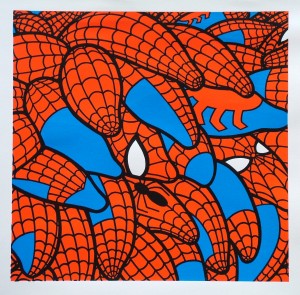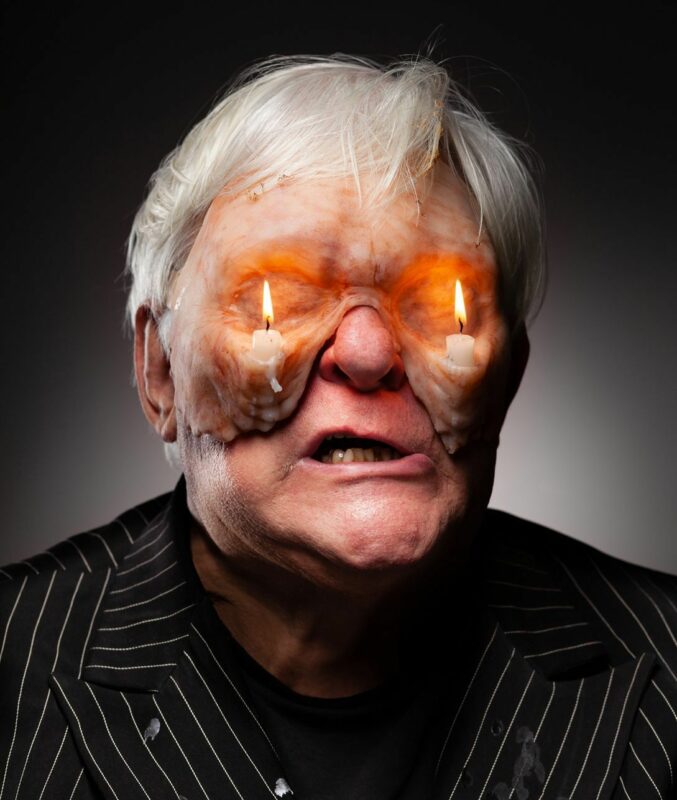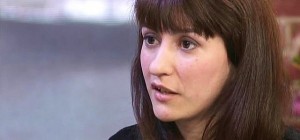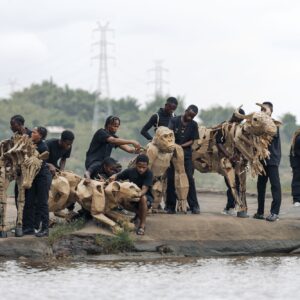
1.When did you start to make art?
As soon as I was old enough to use a pencil. My father was a painter so I suppose growing up with the smell of oil paint and art materials all round the house must have had an influence in my early development.
2.How did you evolve into a professional artist?
I’ve been making art all my life. Even as a school kid I would end up doing design work for friends or local businesses (always for crap money of course).
After leaving Art College in 87 I worked for a Japanese company for four years, illustrating assembly manuals. I then spent the next four years or so as an illustrator for a couple of magazines before going off to university in Northampton to do my BA in Fine Art. It was whilst at university that I switched from printmaking (which I got into after doing a part-time Fine Art BA course at Bourneville) and painting to sculpture, having finally found the medium that allowed me to express myself in the way that I wanted to. After finishing my BA I moved to London where I became involved with various art groups and started exhibiting like a man possessed.
In November 2005 I was awarded a bursary from the Royal British Society of Sculptors and exhibited in their Bursary Show.
I love the London art scene. It’s exhausting, exciting and very addictive. You never know whom you are going to meet or what you might be invited to take part in.
3.What drove you to make art as a professional vocation?
It’s something that I love doing, so the more time I can spend doing it the better.
4.Explain your inspiration?
Difficult. I think the act of seeking inspiration can actually negate the creative process itself. As long as you are in a relaxed, receptive mood you can find inspiration almost anywhere. A lot of my work incorporates found objects and materials (I horde vast amounts of rubbish). These found materials are often, in themselves, very inspirational. I’m very into the tone, texture and form of an object. Colour is not a major concern with me. I’m not always fond of bright or garish colours. Some of my work has incorporated bright colours but there is normally a specific reason for it. Usually something to do with my distain for that particular colour.
Some of my more playful pieces have come about because of drunken conversations, where the mind has just gone off on one (with no inhibitions to apply the breaks). Alcohol and art can be great bedfellows but it’s not something that should be relied upon.
As far as inspiration from other artist goes, I’m probably more influenced by animators like the Brothers Quay and Jan Svankmajer than I am by other sculptors. There are lots of sculptors out there whose work I love but it’s often because they work in a very different way to the way that I work. Then I come across other sculptors who use many of the same materials and objects that I do and that’s great because then I’ve found people of like mind.
5.In what way does your inspiration transform into ideas?
I’m not too sure if there is a set path or formula that my mind chooses. I don’t tend to get many of those ‘eureka’ moments, or if I do, it’s only after I’ve had an indefinable feeling about something and some part of my brain has then gone away to mull it over for a while. It’s almost as if by not paying too much attention to something that you find potentially inspirational your brain will feel free to go off and work it all out for you. Does that make me sound totally detached from my own inner workings? Oh well, it works for me.
6.From ideas to production of art – how? And why?
With my sculptural work everything is worked/scribbled out on paper first. I love my sketchbooks and I love working out on paper the form that a sculpture will eventually take (although some pieces have been notoriously disobedient and refused to go along with this process). The initial sketches are often quite loose but as the work progresses they become tighter and more accurate. Some of the later sketches (especially with the more intricate sculptures) might actually be drawings of sections of the work in progress, which I will then use to draw in, and work out, the next potential stage. I sketch out far more ideas for sculptures than I ever make but at least if I’ve committed them to paper the idea hasn’t been lost. I’ll often come back to an old sketch years later and it’ll inspire me to make something similar (looking at it from a different place in time), having then found the right materials or technique for the job.
7.Could your ideas be portrayed in any other medium? If so which?
I do work in different mediums. It’s just that with sculpture I feel that I’m not expressing my ideas as literally as if I was working in 2D. Drawing is still a very important part of my working practice but with sculpture there seems to be a greater depth of communication of ideas (for me anyway). Maybe with my 2D work I was being far too illustrative.
I find that the slow and physical process of making a sculpture is a good way of realising more fully what was actually going on in my head when I originally came up with the idea.
Or, during the process I come to see things or make connections that I hadn’t realised when I started. Either way, I feel that during the creation process the sculpture seems to reveal more and more of its true self, almost as if it has taken on a life of its own. Even after a piece’s completion I come to see things in it that I hadn’t realised before. I also recognise that ideas and beliefs are not static and that during the creation of an artwork the creative process itself can alter or inform the direction in which the piece evolves.
One of the things that I love about sculpture is that, for me, it exists in the real world in a way that painting or drawing doesn’t. It has multiple viewpoints and can become a very different piece of work, depending upon the venue and context in which it is exhibited.
I love it when people tell me what my work means to them, especially if it is something that I had not seen in the piece. All views are valid. Just because I created a piece doesn’t necessarily mean that my views are the only correct ones. Sculptures can be elusive beasts that give out their secrets slowly.
8.Which artists would you most like to blatantly rip off?
I can’t really see any point in blatantly ripping off another artist’s work, in the same way that I can’t see the point in tribute bands or celebrity look-alikes.
9.Why is your art made?
There are lots of reasons but the original ones still hold true. Namely that I love making art and it makes me happy. I love the process of making something that didn’t exist before and the challenge of having to solve problems that didn’t exist until I created them. If I had never made art I wouldn’t be the person I am, and I like being the person I am.
10. What does being an artist mean to you?
It means being someone who sees things differently or who thinks in a certain way.
11. Are you happy with your reasons for making art? i.e. Are there any
trade offs that make life hard?
Yes, I am happy with my reasons for making art. However, unless you are one of the fortunate few, an artist’s life is not a financially wealthy one. So having to waist valuable time working on things other than your art, just to support yourself, is not great.
12. When does your art become successful?
When it makes me happy.
13. What is art?
Whatever you want it to be.
14. How do you start the process of making work?
With sculpture I’ll normally have some half-formed ideas that I scribble down in my sketchbook. Then I leave it until the ideas start to form more clearly and go back to the sketchbook to sketch them out. I think it’s important not to try and force an idea but to relax and let your mind sort it out. I’m a big advocate of lying around and staring into space. Once I’ve got the initial sketches I just find the tools and materials that I need and start to make the piece – working out the trickier bits, on paper, as I go along.
15.Who prices your work? And how is the price decided upon?
I’m very bad at working out prices for my work.
16.What is your next move, project, show etc.?
I’ve always got a few projects on the go. That way there’s always something I can dip into when the mood takes me and I always have something new to exhibit.
I’m currently involved with a workshop project where I teach sculpture to employees of ING Bank at their HQ on London Wall. This will culminate in a group show of the employees work and I have also been invited to exhibit my work at the bank during the duration of the project.
The Strychnin Gallery recently invited me to make a new piece for their Whaless Show which is an international show dedicated to the plight of the whales. The show has just ended at the Strychnin Gallery and will be travelling to other venues around the world. The piece that I made for the exhibition is a whale skeleton (made from found materials), displayed in a coffin-shaped, wall-mounted display case.
This September, FEFE magazine will be featuring some of my work. FEFE is an, Italian based, international magazine and very issue they invite 25 artists and one child to contribute to the project. The theme for each issue is always a line from a film and September’s line is one of my favourites, “The things you own end up owning you”, from Fight Club. As well as featuring some of my existing work there will be a double page spread of a new painting that I produced especially for them.
In October, Pharos Gallery are organising a group show in the East End of London, and they have asked if I would like to contribute to it. So I’m planning to make a couple of Cyclops figures with illuminated box-shaped heads. They’ll probably look a bit like human-sized, skinny, wooden robots.
I’m also working on a scary mask for a short horror film. Although this is still at the drawing board stage so far. I have some ideas for the piece and I think it will be quite a fun project to work on.
For the past couple of years I’ve been working on a long-term collaborative project with Calum F Kerr but it’s still a secret so I can’t say any more.
In my blog (waynechisnall.blogspot.com) I mention most of my art related activities and advertise any upcoming exhibitions. I’m also using it to sell my latest series of signed and editioned silk-screen prints, Spidey Pods. These prints are also being sold through various galleries throughout East London and through Beyond The Valley off Carnaby Street.
Because of a Sony sponsored script-writing competition that I won (judged by John Malkovich), my blog is now linked directly to Sony’s own website, Club VAIO under their ‘VAIO Heroes’ section. This means that my blog and work gets to be seen by a wider audience. Incidentally, the script has now been turned into an animation.
17.What are the pros and cons of the art market?
There seem to be far more cons than pros!
18.Which pieces would you like to be remembered for?
I wouldn’t mind being remembered for any of my pieces, although I am very fond of my ‘The City’ sculpture and my body of drawings. I think that my life-size model kit piece, ‘And When I’m a Man’, is also quite a good one. But at the end of the day, as long as I’m pleased with whatever I produce I don’t mind what pieces people like or don’t like.
19.Any routine in making your artwork? If so what?
Probably. There is a very ritualistic element to the way that I work and to the way in which I select my materials. I work predominantly in assemblage and with found objects or materials that I feel have a particular ‘resonance’. In some ways I see a lot of my works as totems or magnifications of the ritualistic side of everyday life – physical embodiments of the personal belief systems we all create around us.
20.What has been the biggest break in your career?
It’s hard to say because there have been so many little steps and encounters along the way that have led to interesting opportunities. The other artists and art groups that I have been involved with since moving to London have been incredibly important. Networking is essential for an artist in London, as I’m sure it is everywhere else.
Being awarded the Royal British Society of Sculptures Bursary was definitely a big break because through that I have made some great contacts and been offered exhibitions. Although the decisions to go to university in the first place and to then move to London are probably the biggest career breaks that I have made.
21.Who has been the biggest influence on you?
My parents.
22.How many artworks have you given away and to whom?
Don’t know for sure but my sister has a few of my prints and paintings and a few friends have a lot of my work from when I used to live in Shropshire. I occasionally bump into some old friend and they’ll tell me about some piece of my work that they still have. It’s nice to think that someone values something that you created. Nowadays I don’t give much work away. I get quite attached to my drawings and sculptures and when it comes to exhibiting it’s quite useful to have a large body of work to hand.
more info on Wayne






